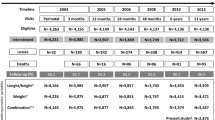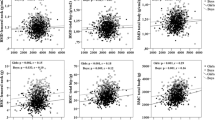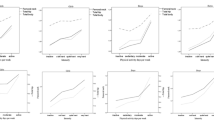Abstract
We investigated the contribution of ethnicity, physical activity, body composition, and calcium intake to bone accrual across 7 years of growth. We assessed 80 Caucasian and 74 Asian boys and 81 Caucasian and 64 Asian girls at baseline and retained 155 children across all 7 years. Ethnicity, physical activity, and calcium intake were assessed by questionnaire; fat mass, lean mass, and bone mineral content (BMC) of the whole body (WB), lumbar spine (LS), total proximal femur (PFTOT), and femoral neck (FN) were measured using DXA (Hologic QDR 4500). We aligned children on peak height velocity and utilized multilevel modeling to assess bone mineral accrual. Height and lean mass accounted for 51.8% and 44.1% of BMC accrual in children. There was a significant difference in physical activity, calcium intake, and lean mass between Asians and Caucasian boys and girls at baseline and conclusion (p < 0.05). In boys, physical activity and ethnicity significantly predicted BMC accrual at the FN. In girls, Asians had significantly lower PFTOT and FN BMC. Calcium was a significant predictor of WB BMC accrual in boys and girls. In conclusion, our findings highlight the importance of accounting for ethnicity in pediatric studies. Physical activity, dietary calcium, and lean mass positively influence bone accrual and are lower in Asian compared to Caucasian children from a very young age.


Similar content being viewed by others
References
Heaney R, Abrams S, Dawson-Hughes B, Looker A, Marcus R, Matkovic V, Weaver C (2000) Peak bone mass. Osteoporosis Int 11:985–1009
Bailey DA, McKay HA, Mirwald RL, Crocker PR, Faulkner RA (1999) A six-year longitudinal study of the relationship of physical activity to bone mineral accrual in growing children: The University of Saskatchewan Bone Mineral Accrual Study. J Bone Miner Rese 14:1672–1679
Lei SF, Chen Y, Xiong DH, Li LM, Deng HW (2006) Ethnic differences in osteoporosis-related phenotypes and its potential underlying genetic determination. J Musculoskelet Neuronal Interact 6:36–46
McKay HA, Petit MA, Khan KM, Schutz RW (2000) Lifestyle determinants of bone mineral: a comparison between prepubertal Asian- and Caucasian-Canadian boys and girls. Calc Tissue Int 66:320–324
Bachrach LK, Hastie T, Wang MC, Narasimhan B, Marcus R (1999) Bone mineral acquisition in healthy Asian, Hispanic, black, and Caucasian youth: a longitudinal study. J Clin Endocrinol Metab 84:4702–4712
Mckay H, Smith E (2008) Winning the battle against childhood physical inactivity: the key to bone strength? J Bone Miner Res 23:980–985
Hind K, Burrows M (2007) Weight-bearing exercise and bone mineral accrual in children and adolescents: a review of controlled trials. Bone 40:14–27
Carter LM, Whiting SJ (1997) Effect of calcium supplementation is greater in prepubertal girls with low calcium intake. Nutr Rev 55:371–373
Forwood MR, Baxter-Jones AD, Beck TJ, Mirwald RL, Howard A, Bailey DA (2006) Physical activity and strength of the femoral neck during the adolescent growth spurt: a longitudinal analysis. Bone 38:576–583
Rauch F, Bailey DA, Baxter-Jones A, Mirwald R, Faulkner R (2004) The ‘muscle-bone unit’ during the pubertal growth spurt. Bone 34:771–775
Frost HM (2000) Muscle, bone, and the Utah paradigm: a 1999 overview. Med Sci Sports Exerc 32:911–917
Gunter K, Baxter-Jones ADG, Mirwald RL, Almstedt H, Fuchs R, Durski S, Snow C (2008) Impact exercise increases BMC during growth: an 8 year longitudinal study. J Bone Miner Res 23:986–993
Janz K, Eichenberger-Gilmore J, Levy S, Letuchy E, Burns T, Beck T (2007) Physical activity and femoral neck bone strength during childhood: the Iowa bone development study. Bone 41:216–222
Gunter K, Baxter-Jones ADG, Mirwald RL, Almstedt H, Fuller A, Durski S, Snow C (2008) Jump starting skeletal health: a 4-year longitudinal study assessing the effects of jumping on skeletal development in pre and circum pubertal children. Bone 42:710–718
Fuchs RK, Snow CM (2002) Gains in hip bone mass from high-impact training are maintained: a randomized controlled trial in children. J Pediatr 141:357–362
Bailey DA, Baxter-Jones AD, Mirwald RL, Faulkner RA (2003) Bone growth and exercise studies: the complications of maturation. J Musculoskel Neurol Interact 3:335–337. discussion 356
Martin R, Burr DB, Sharkey NA (1998) Skeletal tissue mechanics. Springer, New York
Bonat S, Pathomvanich A, Keil MF, Field AE, Yanovski JA (2002) Self-assessment of pubertal stage in overweight children. Pediatrics 110:743–747
Baxter-Jones A, Mirwald RM (2004) Multilevel modeling. In: Hauspie RC, Cameron N, Molinari L (eds) Methods in human growth research. Cambridge University Press, Cambridge, UK, pp 306–329
MacKelvie KJ, McKay HA, Khan KM, Crocker PR (2001) A school-based exercise intervention augments bone mineral accrual in early pubertal girls. J Pediatr 139:501–508
Petit MA, McKay HA, MacKelvie KJ, Heinonen A, Khan KM, Beck TJ (2002) A randomized school-based jumping intervention confers site and maturity-specific benefits on bone structural properties in girls: a hip structural analysis study. J Bone Miner Res 17:363–372
Crocker PR, Bailey DA, Faulkner RA, Kowalski KC, McGrath R (1997) Measuring general levels of physical activity: preliminary evidence for the Physical Activity Questionnaire for Older Children. Med Sci Sports Exerc 29:1344–1349
McKay HA, Bailey DA, Mirwald RL, Davison KS, Faulkner RA (1998) Peak bone mineral accrual and age at menarche in adolescent girls: a 6-year longitudinal study. J Pediatr 133:682–687
Mirwald RL, Baxter-Jones AD, Bailey DA, Beunen GP (2002) An assessment of maturity from anthropometric measurements. Med Sci Sports Exerc 34:689–694
Barr SI (1994) Associations of social and demographic variables with calcium intakes of high school students. J Am Diet Assoc 94:260–266
Baxter-Jones A, Eisenmann J, Mirwald R, Faulkner R, Bailey D (2008) The influence of physical activity on lean mass accrual during adolescence: a longitudinal analysis. J Appl Physiol 105(2):734–741
Food and Nutrition Food Board (2003) Dietary reference intakes: applications in dietary planning. National Academies Press, Washington, DC
Garn SM (1970) The earlier gain and later loss of cortical bone. Charles C Thomas, Springfield, IL
Martin AD, Bailey DA, McKay HA, Whiting S (1997) Bone mineral and calcium accretion during puberty. Am J Clin Nutr 66:611–615
Heyman MB (2006) Lactose intolerance in infants, children, and adolescents. Pediatrics 118:1279–1286
MacKelvie KJ, Petit MA, Khan KM, Beck TJ, McKay HA (2004) Bone mass and structure are enhanced following a 2-year randomized controlled trial of exercise in prepubertal boys. Bone 34:755–764
Bradney M, Pearce G, Naughton G, Sullivan C, Bass S, Beck T, Carlson J, Seeman E (1998) Moderate exercise during growth in prepubertal boys: changes in bone mass, size, volumetric density, and bone strength: a controlled prospective study. J Bone Miner Res 13:1814–1821
Metcalf BS, Voss LD, Hosking J, Jeffery AN, Wilkin TJ (2008) Physical activity at the government-recommended level and obesity-related health outcomes: a longitudinal study (EarlyBird 37). Arch Dis Child 93(9):772–777
Weaver CM, McCabe LD, McCabe GP, Novotny R, Van Loan M, Going S, Matkovic V, Boushey C, Savaiano DA ACT, Team Research (2007) Bone mineral and predictors of bone mass in White, Hispanic and Asian early pubertal girls. Calc Tissue Int 81:352–363
Xu H, Chen J-X, Gong J, Zhang T-M, Wu Q-L, Yuan Z-M, Wang J-P (2007) Normal reference for bone density in healthy Chinese children. J Clin Densitom 10:266–275
Baxter-Jones A, Kontulainen S, Faulkner RA, Bailey DA (2008) Benefits of physical activity on bone mineral content during childhood and adolescence are maintained into young adulthood: a 14 year longitudinal study. J Appl Physiol (in press)
Weeks BK, Young CM, Beck BR (2008) Eight months of regular in-school jumping improves indices of bone strength in adolescent boys and girls: the POWER PE Study. J Bone Miner Res 23:1002–1011
Iuliano-Burns S, Mirwald RL, Bailey DA (2001) Timing and magnitude of peak height velocity and peak tissue velocities for early, average and late maturing boys and girls. Am J Hum Biol 13:1–8
Petit MA, Beck TJ, Shults J, Zemel BS, Foster BJ, Leonard MB (2005) Proximal femur bone geometry is appropriately adapted to lean mass in overweight children and adolescents. Bone 36:568–576
Burr DB (1997) Muscle strength, bone mass, and age-related bone loss. J Bone Miner Res 12:1547–1551
Petit M, Beck TJ, Hughes JM, Lin HM, Bentley C, Lloyd T (2008) Proximal femur mechanical adaptation to weight gain in late adolescence: a six-year longitudinal study. J Bone Miner Res 23:180–188
McCormick DP, Ponder SW, Fawcett HD, Palmer JL (1991) Spinal bone mineral density in 335 normal and obese children and adolescents: evidence for ethnic and sex differences. J Bone Miner Res 5:507–513
Parfitt AM (1994) The two faces of growth: benefits and risks to bone integrity. Osteopor Int 4:382–398
Duncan EL, Cardon LR, Sinsheimer JS, Wass JA, Brown MA (2003) Site and gender specificity of inheritance of bone mineral density. J Bone Miner Res 18:1531–1538
Micklesfield LK, Norris SA, Nelson DA, Lambert EV, van der Merwe L, Pettifor JM (2007) Comparisons of body size, composition, and whole body bone mass between North American and South African children. J Bone Miner Res 22:1869–1897
Acknowledgments
The UBC Healthy Bones Study II (1999–2006) was supported by a Canadian Institute for Health Research project grant (20RNO793). Additional support was provided by a Michael Smith Foundation for Health Research grant (20R41770). Professor McKay is a Michael Smith Foundation for Health Research Senior Scholar. Dr. Macdonald is an Alberta Heritage Foundation for Medical Research postdoctoral trainee. We extend our heartfelt thanks to the students, staff, and parents in the Richmond School District for their continued support and participation in this study. We acknowledge and are grateful for Dr. MacKelvie-O’Brien’s considerable contribution during the first 2 years of the study. Without the superhuman efforts of Deetria Egeli, who brings these children (and now young adults) back each year—this study would not be possible. Finally, we thank all staff at the Centre for Hip Health and Mobility for their skill, due diligence, and ongoing support.
Author information
Authors and Affiliations
Corresponding author
Rights and permissions
About this article
Cite this article
Burrows, M., Baxter-Jones, A., Mirwald, R. et al. Bone Mineral Accrual Across Growth in a Mixed-Ethnic Group of Children: Are Asian Children Disadvantaged from an Early Age?. Calcif Tissue Int 84, 366–378 (2009). https://doi.org/10.1007/s00223-009-9236-8
Received:
Accepted:
Published:
Issue Date:
DOI: https://doi.org/10.1007/s00223-009-9236-8




